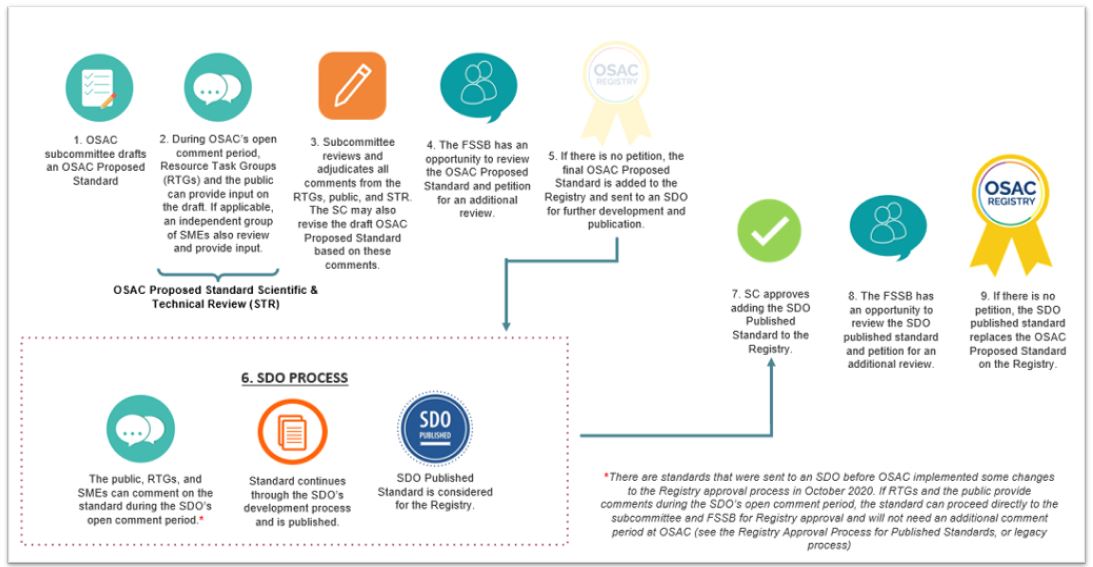Registry Approval Process
OSAC works to ensure the highest-quality standards are available to the forensic science community. To do this, we evaluate published and proposed standards using two processes:
- Registry Approval Process for OSAC Proposed Standards. Effective October 1, 2020, this process is used to review OSAC drafted standards (i.e., OSAC proposed standards) for technical quality and placement on the Registry before they are sent to a standards developing organization (SDO) for further development and publication.
- Registry Approval Process for Published Standards. In this legacy process (effective February 2020 - present), existing standards are reviewed for technical quality and placement on the Registry after they have been published by an SDO.
Registry Approval Process for OSAC Proposed Standards

- The Registry Approval Process for OSAC Proposed Standards starts when OSAC drafts a new standard.
- After the draft OSAC Proposed Standard has been completed, OSAC will open a 30-day comment period where stakeholders from the forensic science community are invited to submit feedback. During the same time, the Forensic Science Standards Board (FSSB) Resource Task Groups (RTGs) are encouraged to review the draft and submit comments. Additionally, and if applicable, an independent group of subject matter experts will evaluate the draft according to set criteria and provide comments to the drafting subcommittee (see the Scientific & Technical Review Process webpage for more information on this process).
- After the 30-day comment period closes, the subcommittee will review and adjudicate the comments received from the public, RTGs, and STR. The subcommittee may also revise the draft OSAC Proposed Standard based on these comments. After the comments have been adjudicated and any revisions made to the standard, the subcommittee will vote to move the draft to the FSSB for review.
- The FSSB is provided with the OSAC Proposed Standard and the adjudicated comments, and they are given an opportunity review this information and petition adding the OSAC Proposed Standard to the Registry. If a petition for additional review is granted, then the FSSB will discuss the OSAC Proposed Standard and vote whether to place it on the Registry.
- If there is no petition for additional FSSB review, then the OSAC Proposed Standard is listed on the Registry and is sent to an SDO for further development and publication. To help fill the standards gap during the time it takes for an SDO to complete the standards development process, OSAC encourages forensic science service providers to implement these high-quality proposed standards.
- The OSAC Proposed Standard proceeds through the SDO's specific consensus-based development process. While at the SDO, the public, RTGs, and other interested stakeholders have another opportunity to provide comments on the document. The SDO process may take several years, and in the end, results in a published standard.
- Note: There are standards that were sent to an SDO prior to October 2020 (see the Registry Approval Process for Published Standards, or legacy process). If RTGs and the public provide comments during an SDO's open comment period, the standard can proceed directly to the subcommittee and FSSB for approval and will not need an additional comment period at OSAC.
- After the standard is published by the SDO, the subcommittee determines whether to add it to the Registry.
- The FSSB will have an opportunity to review and petition adding the SDO published standard to the Registry. If a petition for additional review is granted, then the FSSB will discuss the published standard and vote whether to place it on the Registry.
- If there is no petition, the SDO published standard will replace the OSAC Proposed Standard on the Registry.
Created October 1, 2020, Updated March 28, 2025

